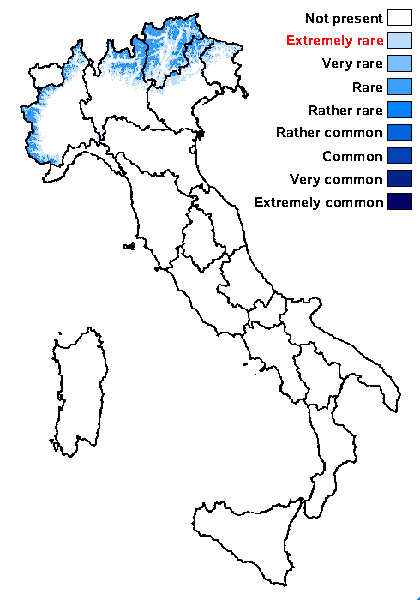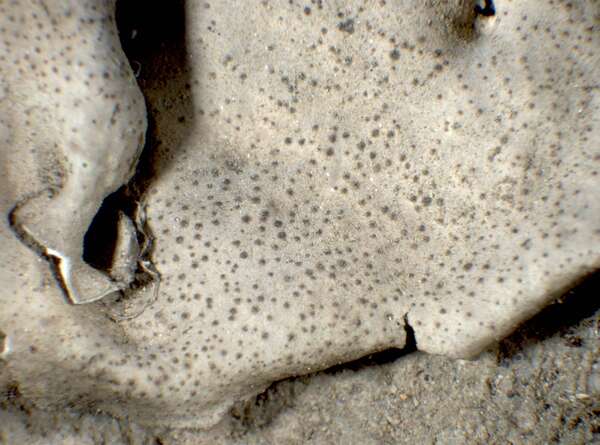Dermatocarpon arnoldianum Degel.
Nytt Mag. Naturvid., 75: 157, 1934.
Synonyms:
Distribution: N - Frl (TSB 25120), Ven (Nascimbene 2004), TAA (Nascimbene & al. 2022), Lomb, Piem (TSB 34466).
Description: Thallus foliose-umbilicate, attached by a central holdfast, usually monophyllous, 0.6-5 cm broad, 0.4-0.7 mm thick, growing amphibious in cold freshwaters. Upper surface smooth or slightly rippled, grey to (rarely) grey-brown when dry, greenish when wet, pruinose or epruinose; lower surface bright red-brown to yellowish, smooth to ridged but not veined, erhizinate. Upper cortex 90-260 µm thick, pseudoparenchymatous, of anticlinallly arranged hyphae, often with a brown pigment near the surface, overlain by an epinecral layer of air-filled hyphae; lower cortex c. of the same thickness, of anticlinally arranged hyphae; medulla white, I- or I+ reddish brown. Perithecia numerous, immersed in the thallus and scattered over almost the whole upper surface (appearing as black dots), without involucrellum. Exciple colourless except in the brown uppermost part; hamathecium of periphyses and periphysoids, interascal filaments absent; hymenial gel hemiamyloid. Asci 8-spored, clavate, I-, fissitunicate, the wall thickened above, with an ocular chamber, dehiscent by extrusion of an endotunica to form a delicate rostrum, Verrucaria-type. Ascospores 1-celled, hyaline, elongate-ellipsoid, (9-)13-17 x 4-7 µm. Pycnidia rare, black, immersed, multi-chambered. Conidia short-bacilliform, 4-5 µm long. Photobiont chlorococcoid. Spot tests: cortex and medulla K-, C-, KC-, P-, UV-. Chemistry: without lichen substances.Note: a rather poorly understood, but characteristic, perhaps holarctic species found on calciferous or base-rich siliceous rocks in periodically wet places, or near the ground in upland areas. According to Heidmarsson (2017), however, this is just a morph of D. miniatum. As the molecular taxonomy of the D. miniatum-complex is not fully resolved, I prefer to provisionally maintain the taxon as distinct.
Growth form: Foliose, umbilicate
Substrata: rocks
Photobiont: green algae other than Trentepohlia
Reproductive strategy: mainly sexual
Periodically submerged (e.g. in creeks)
Poorly known taxon in need of further study
Commonnes-rarity: (info)
Alpine belt: rare
Subalpine belt: rather rare
Oromediterranean belt: extremely rare
Montane belt: extremely rare
Submediterranean belt: absent
Padanian area: absent
Humid submediterranean belt: absent
Humid mediterranean belt: absent
Dry mediterranean belt: absent

Predictive model
Herbarium samples
Growth form: Foliose, umbilicate
Substrata: rocks
Photobiont: green algae other than Trentepohlia
Reproductive strategy: mainly sexual
Periodically submerged (e.g. in creeks)
Poorly known taxon in need of further study
Commonnes-rarity: (info)
Alpine belt: rare
Subalpine belt: rather rare
Oromediterranean belt: extremely rare
Montane belt: extremely rare
Submediterranean belt: absent
Padanian area: absent
Humid submediterranean belt: absent
Humid mediterranean belt: absent
Dry mediterranean belt: absent

Predictive model
| Herbarium samples |
 Index Fungorum
Index Fungorum
 GBIF
GBIF




